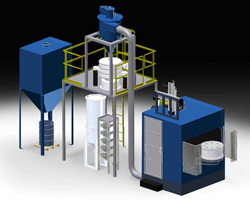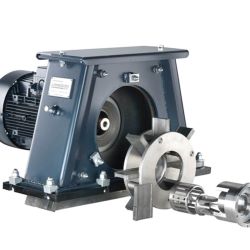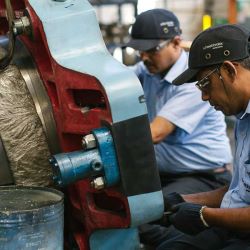A clever combination of two blast technologies in one machine has increased throughput for a manufacturer of aircraft wheels. The wheels measure up 30" in diameter, and can be processed at 2 minutes per wheel side, meaning that up to 15 wheels can be processed in one hour. Wheelabrator combined a peening machine with wheelblast technology and a machine with an automated airblast peening system to achieve ultimate shot peening results.
Challenges
When the wheel peening application was first assessed, there seemed a clear need for three machines. Wheelabrator challenged this need, and innovatively proposed a two-machine solution.
The two new peening machines have now been installed and have reduced process time and increased efficiency for shot peening aluminium aircraft wheels. The custom design from Wheelabrator combines three peening processes into two machines, maximizing the overall throughput.
Shot peening adds residual compressive stresses, improves fatigue and crack resistance, and extends the life span of aircraft wheels and components.
Utilising wheelblast technology, the large surfaces of the aircraft wheels can be shot peened effectively. The inclusion of the automated airblast peening system meant that the intricate areas of the wheel could also be processed. The hybrid machine ensures complete coverage of the aircraft component.
With varying wheel sizes of 12 to 30 inch diameters, this inventive combination of peening technologies has shortened process time to 2 minutes per wheel side.
Ron Wright, Shot Peening Sales Manager for Wheelabrator Group, explained: “The hybrid design is the best solution for precise treatment of components that have both large surfaces and complex areas. Instead of having two separate machines with separate processes, Wheelabrator combined the processes into one.”
Solution
Following the initial peening process with the hybrid machine, which utilizes steel shot, aircraft wheels may require additional strengthening treatments.
Wheelabrator concludes this process with the glass bead peening machine. Glass bead peening further increases the fatigue strength of a component while giving a satin finish surface. The glass bead peening process can replace a less efficient and less flexible burnishing operation.
The Wheelabrator glass bead peening machine has a nozzle-style apparatus to accurately focus the direction of the media onto the complex components. A six axis standard robot is used to manipulate the nozzle to sufficiently peen the variations on the components surface. After the peening process is complete, the intensity of the peening effects is measured with an Almen strip and recorded for quality control and compliance with standards.

Result
The two machines are fully computer controlled and monitored to meet the demanding aerospace standards: AMS 2432 for peening and NADCAP audit criteria.
In a high production facility, fast processing and high quality standards are critical. The innovative equipment from Wheelabrator helps achieve these needs in the aerospace industry.


